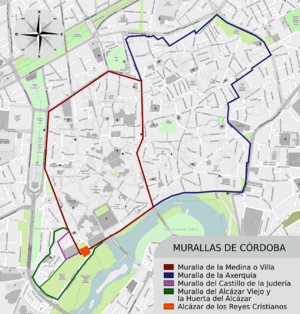Roman walls of Córdoba facts for kids
The Roman Walls are ancient walls that used to surround the city of Córdoba in Spain. The Romans built them after they took over the city in 206 BC, making Córdoba part of the Roman Republic. Today, these old walls are part of Córdoba's historic center, which is a special place recognized by UNESCO as a World Heritage Site.
Building the Roman Walls
The Romans built these walls to protect Córdoba soon after they captured the city. The walls were very long, stretching about 2,650 m (8,690 ft) (that's more than 1.5 miles!). They completely surrounded the city.
The walls were made from carefully cut stones. They had an outer wall that was up to 3 m (9.8 ft) (about 10 feet) tall. There was also an inner wall, about 1.2 m (3 ft 11 in) (4 feet) tall. Between these two walls was a gap 6 m (20 ft) (about 20 feet) wide, filled with rocks and rubble. Along the walls, there were several round towers for extra protection.
Changes Over Time
Later, when Córdoba became a very important city called "Colonia Patricia" under the Roman Emperor Augustus, some changes were made. The southern part of the wall was taken down. This allowed the city to grow closer to the river.
You can still see parts of the Roman Walls today! Some sections are near the Alcázar and close to the Roman bridge. Other parts are along the Avenida de la Ribera. The walls next to Calle San Fernando and Calle Cairuán also have Roman foundations. These sections were restored in the 1950s. You can even see a piece of the Roman wall from the street next to the Roman temple.
Roman Gates and Waterways
The Roman Walls had several gates that allowed people to enter and exit the city. One important gate was the Porta Principalis Sinistra. This gate was on the west side, not far from the Roman mausoleum. Later, it was known as Puerta de Gallegos.
Near the Puerta de Sevilla, you can see some arches. These arches were actually part of a Roman aqueduct. An aqueduct was like a bridge that carried water into the city.
See also
 In Spanish: Murallas de Córdoba para niños
In Spanish: Murallas de Córdoba para niños



